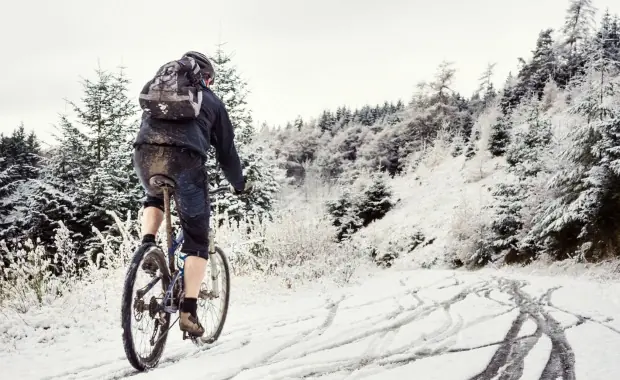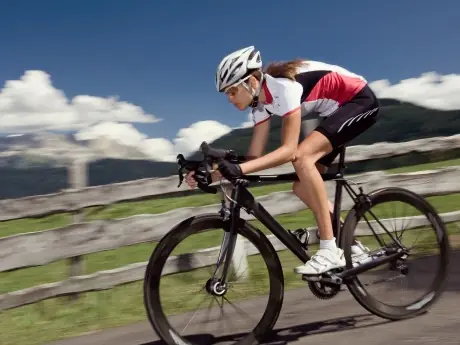
Dressing properly for snowy, cold, wet, or freezing rides is challenging; it's even tougher if you only got into cycling this summer and are suddenly finding your fingers frozen mid-ride. By wearing several key pieces of clothing and following a few important rules, you can stay warm this winter without breaking the bank. Never leave the house dressed improperly again!
Know Your Conditions
Will you be riding in frigid but dry conditions like in the Rocky Mountains, or will you be pedaling along in damp-to-wet bone-chilling conditions like in the Pacific Northwest?
In drier climates, begin with a softshell. "There is a dizzying diversity of softshells out there, but most are windproof, water resistant, and warm for conditions below 40 degrees," says Jason Fryda, senior product manager with Bontrager.
However, for rain and snow, put a hardshell layer on top of the softshell to create a barrier between your body and precipitation. Rain jackets and rainproof pants may be in order, but not all are created equal: Some offer more breathability than others.
In especially chilly or windy conditions, layers with windstopping properties work well and help you retain more body heat.
Pick the Right Fabric
Technological innovations in fabric mean that polyester is no longer the laughingstock of the high performance world, and it's a cheap way to bulk up your winter wardrobe.
"For your upper body and for layering, just about everything these days is made out of polyester," explains Zach Terry, product manager for apparel and footwear at Performance, Inc. "The technology has gotten so advanced, and there are so many different types of poly that achieve different things depending on the conditions. You can't go wrong." Opting for a softshell made with polyester is a smart move.
If you can afford it, Merino wool is a great option for keeping warm. It wicks sweat and gets slightly less smelly than polyester. Wool garments are more like investment pieces that will last for several years.
"Merino base layers and items I can wear more than once between washings are the best," says Derrick Lewis, Rapha's North American communications and retail manager. "Winter gear is expensive, and I only have the time for laundry once a week." If you have a lot of travel planned, wool is ideal.
Always avoid cotton for base layers. Most beginners will unknowingly grab a cotton undershirt and wear it beneath a jersey the first time temperatures drop, but cotton quickly soaks up sweat and stays wet, making you colder than you would have been without it. Cotton can also cause chafing, and it's heavier due to how well it retains water and sweat. "Generally speaking, when wearing cotton, you'll be totally miserable and never want to ride outside again," says Terry.
More: Winter Layering Done Right
Upgrade from Summer to Winter with Legwarmers
If you don't have fancy winter tights with an integrated chamois, try buying a pair of legwarmers and wearing them with your shorts. Or if you are runner, don your running tights atop your bike shorts.
All three of our experts noted that thermal fabrics are ideal for keeping warm, so don't just throw on your lightweight yoga leggings; instead, opt for thermal tights or legwarmers.
But whatever you do, don't put the leggings under the chamois! (And to those of you scoffing at that note, just remember, we were all beginners once!)
Carry a Spare
Even if you're dressed for the coldest conditions, pack a thin windbreaker into one of your pockets so you have a spare layer in case temperatures drop even more. Don't be caught off guard.
Keeping a fresh set of hand warmers—such as the chemical kind that you shake to activate—in your saddlebag in case your hands go numb is also a smart move. If you're willing to carry extra gear, pack a spare pair of socks, especially if your feet might get wet en route. It's easy to swap socks at a mid-ride stop.
Don't Skimp on the Accessories
You lose substantial body heat through your head, your feet and your hands—and you need all three of those working well to be able to make it home safely. So get a good cold weather cap that covers your ears; a pair of sunglasses—even clear lenses—to keep your eyeballs covered; a warm pair of gloves and warm socks or shoe covers. Nothing ruins a ride faster than cold fingers and toes, and you can get permanent damage from frostbite before you realize it!
"When you are riding in weather below 40 degrees, you should have an extra hat along to change into for the second half of the ride," says Fryda. "Whether you stop for a coffee or a mid-ride flat, the second hat is clutch. There is also something awesome about a giant cappuccino and a wool cap perched atop sweat-frozen hair in the caf?."
More: How to Stay Warm on Mountain Bike Rides
Avoid Overdressing
Our three experts agreed that one of the biggest mistakes made by beginners is overdressing. A good rule of thumb is to feel a little chilly when you leave the house—but if you don't warm up after a few minutes, put on that extra jacket you brought!
"You can't wear the same amount of layers as if you were just sitting around outside in the cold," Terry explains. "When you're out riding, you're generating sweat and heat that needs to leave the body, transfer through your various layers, evaporate out in to the world and keep you relatively dry and warm underneath."
Riding with a base layer, three jerseys and a jacket will be too much in all but the most extreme situations. Over-clad riders may overheat and run out of room to stow layers as they peel them off, and they may get cold while stopped alongside the road trying to juggle layers.
Fryda also cautions against skimping on coverage of your neck, torso, and chest. Keeping these parts of the body warm will make you feel warmer overall.
Use Embrocation with Care
You may be tempted to use a little bit of embrocation—warming goop that heats up on contact with your skin—but be forewarned: apply it with caution and avoid any contact with your face and with your nether regions. Try using a latex glove when applying the embrocation, then immediately throw it away to keep from getting it on the wrong body parts.
Read the original article published on Bicycling.com.
 Ready to Ride? Search for a cycling event.
Ready to Ride? Search for a cycling event.About the Author










Discuss This Article